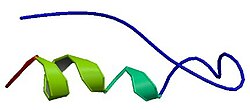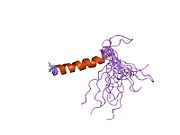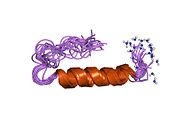Peptide YY
| PYY | |||||||||||||||||||||||||||||||||||||||||||||||||||
|---|---|---|---|---|---|---|---|---|---|---|---|---|---|---|---|---|---|---|---|---|---|---|---|---|---|---|---|---|---|---|---|---|---|---|---|---|---|---|---|---|---|---|---|---|---|---|---|---|---|---|---|
 | |||||||||||||||||||||||||||||||||||||||||||||||||||
| |||||||||||||||||||||||||||||||||||||||||||||||||||
| Identifiers | |||||||||||||||||||||||||||||||||||||||||||||||||||
| Aliases | PYY,PYY-I, PYY1, peptide YY | ||||||||||||||||||||||||||||||||||||||||||||||||||
| External IDs | OMIM:600781;MGI:99924;HomoloGene:3066;GeneCards:PYY;OMA:PYY - orthologs | ||||||||||||||||||||||||||||||||||||||||||||||||||
| |||||||||||||||||||||||||||||||||||||||||||||||||||
| |||||||||||||||||||||||||||||||||||||||||||||||||||
| |||||||||||||||||||||||||||||||||||||||||||||||||||
| |||||||||||||||||||||||||||||||||||||||||||||||||||
| |||||||||||||||||||||||||||||||||||||||||||||||||||
| Wikidata | |||||||||||||||||||||||||||||||||||||||||||||||||||
| |||||||||||||||||||||||||||||||||||||||||||||||||||
Peptide YY(PYY), also known aspeptide tyrosine tyrosine,is a peptide that in humans is encoded by thePYYgene.[5]Peptide YY is a short (36-amino acid) peptide released from cells in theileumandcolonin response to feeding. In the blood, gut, and other elements of periphery, PYY acts to reduce appetite; similarly, when injected directly into the central nervous system, PYY is alsoanorexigenic,i.e., it reduces appetite.[6]
Dietary fibersfrom fruits, vegetables, and whole grains, consumed, increase the speed of transit of intestinalchymeinto theileum,to raise PYY3-36,and induce satiety. Peptide YY cannot be produced as the result of enzymatic breakdown of crude fish proteins and ingested as a food product.[7]
Structure
[edit]Peptide YY is related to thepancreatic peptidefamily by having 18 of its 36 amino acids located in the same positions as pancreatic peptide.[8]The two major forms of peptide YY are PYY1-36and PYY3-36,which have PP fold structural motifs. However, the most common form of circulating PYY immunoreactivity is PYY3-36,which binds to theY2receptor (Y2R)of theY familyof receptors.[9]Peptide YY3-36(PYY) is a linearpolypeptideconsisting of 34amino acidswith structuralhomologytoNPYandpancreatic polypeptide.
The PP-fold motif is found throughout this family and relates to the 3D structure. The PP-fold is formed through the incorporation of certain residues which are predominately Pro2, Pro5, Pro8, Gly9, Tyr20 and Tyr27. This PP-fold has been found to protect the peptide against enzymatic attack as well as producing a hydrophobic pocket which is inherently overall energy reducing. In addition to containing the PP-fold motif, PYY and its derivative PYY3- 36 also have a high C-terminal α-helix proportion, suggested to be extremely important for the structural integrity of PYY.[10]
Release
[edit]PYY is found inL cellsin themucosaofgastrointestinal tract,especially inileumandcolon.Also, a small amount of PYY, about 1-10%, is found in theesophagus,stomach,duodenumandjejunum.[11]PYY concentration in the circulation increases postprandially (after food ingestion) and decreases byfasting.[9]In addition, PYY is produced by a discrete population of neurons in thebrainstem,specifically localized to thegigantocellular reticular nucleusof themedulla oblongata.[12]C. R. Gustavsenet al.had found PYY-producing cells located in theislets of Langerhansin rats. They were observed either alone or co-localized with glucagon or PP.[13]
PYY is released by the L-cells of the gastrointestinal tract following food intake, and there are two main endogenous forms: PYY1-36and PYY3-36.PYY1-36is rapidly processed by the enzymeDPP4to the 34-amino acid peptide PYY3-36.<[14]DPP4 hydrolyses PYY and removes the first two amino acids, tyrosine and proline, at the N-terminal, which changes the receptor selectivity. As a result of this, PYY3-36has a high selectivity for theY2-receptor,compared to PYY1-36which has selectivity for the Y1, Y2, and Y5 receptors. It is thought that the Y1 receptor requires both the C-terminus and N-terminus for recognition, binding and then subsequent activation. The Y2 receptor is thought to have a smaller receptor site and also only requires the C-terminus for recognition.
This could explain the reduced affinity for PYY3-36on any other Y receptor other than Y2.[15]Other studies replacing the amide bonds with ester bonds also confirm that the end section is important in binding and activation.[16]The Y2 receptors are located in the hippocampus, sympathetic and parasympathetic nerve fibres, intestines, and certain blood vessels, and have been implicated in regulating food intake and gastric emptying.[17]As a result of this, the Y2 receptor is considered a target for the treatment of obesity and type II diabetes.
Function
[edit]PYY exerts its action throughNPY receptors;it inhibitsgastric motilityand increases water andelectrolyteabsorption in the colon.[18]PYY may also suppresspancreaticsecretion.It is secreted by theneuroendocrine cellsin theileumandcolonin response to a meal, and has been shown to reduceappetite.PYY works by slowing the gastric emptying; hence, it increases efficiency of digestion and nutrient absorption after a meal. Research has also indicated PYY may be useful in removingaluminiumaccumulated in thebrain.[citation needed]
Animal studies
[edit]Several studies have shown acute peripheral administration of PYY3-36inhibits feeding of rodents and primates. Other studies onY2R-knockout micehave shown noanorecticeffect on them. These findings indicate PYY3-36has an anorectic (losing appetite) effect, which is suggested to be mediated by Y2R. PYY-knockout female mice increase in body weight and fat mass. PYY-knockout mice, on the other hand, are resistant toobesity,but have higher fat mass and lower glucose tolerance when fed a high-fat diet, compared to control mice. Thus, PYY also plays a very important role in energy homeostasis by balancing food intake.[9]PYY oral spray was found to promote fullness.[19]Viral gene therapy of the salivary glands resulted in long-term intake reduction.[20]
Relevance to obesity
[edit]Leptinalso reduces appetite in response to feeding, butobesepeople develop a resistance to leptin. Obese people secrete less PYY than non-obese people,[21]and attempts to use PYY directly as a weight-loss drug have met with some success. Researchers noted the caloric intake during a buffet lunch offered two hours after the infusion of PYY was decreased by 30% in obese subjects (p < 0.001) and 31% in lean subjects (p < 0.001).[22]
While some studies have shown obese persons have lower circulating level of PYY postprandially, other studies have reported they have normal sensitivity to theanorecticeffect of PYY3-36.Thus, reduction in PYY sensitivity may not be one of the causes of obesity, in contrast to the reduction of leptin sensitivity. The anorectic effect of PYY could possibly be a future obesity drug.[9]
The consumption of protein boosts PYY levels, so some benefit was observed in experimental subjects in reducing hunger and promoting weight loss.[23]This could partially explain the weight-loss experienced withhigh-protein diets,noting also the highthermic effect of protein.
Obese patients undergoing gastric bypass showed marked metabolic adaptations, resulting in frequent diabetes remission 1 year later. When the confounding of calorie restriction is factored out, β-cell function improves rapidly, very possibly under the influence of enhancedGLP-1responsiveness. Insulin sensitivity improves in proportion to weight loss, with a possible involvement of PYY.[24]
See also
[edit]References
[edit]![]() This article incorporatestextby Jessica Hutchinson available under theCC BY 3.0license.
This article incorporatestextby Jessica Hutchinson available under theCC BY 3.0license.
- ^abcGRCh38: Ensembl release 89: ENSG00000131096–Ensembl,May 2017
- ^abcGRCm38: Ensembl release 89: ENSMUSG00000017311–Ensembl,May 2017
- ^"Human PubMed Reference:".National Center for Biotechnology Information, U.S. National Library of Medicine.
- ^"Mouse PubMed Reference:".National Center for Biotechnology Information, U.S. National Library of Medicine.
- ^EntrezGene5697
- ^Woods SC, D'Alessio DA (November 2008)."Central control of body weight and appetite".The Journal of Clinical Endocrinology and Metabolism.93(11 Suppl 1): S37–S50.doi:10.1210/jc.2008-1630.PMC2585760.PMID18987269.
- ^Murashita K, Kurokawa T, Nilsen TO, Rønnestad I (February 2009). "Ghrelin, cholecystokinin, and peptide YY in Atlantic salmon (Salmo salar): molecular cloning and tissue expression".General and Comparative Endocrinology.160(3): 223–235.doi:10.1016/j.ygcen.2008.11.024.PMID19073185.
- ^DeGroot LJ (1989). McGuigan JE (ed.).Endocrinology.Philadelphia: Saunders. p.2754.ISBN978-0-7216-2888-2.
- ^abcdMurphy KG, Bloom SR (December 2006). "Gut hormones and the regulation of energy homeostasis".Nature.444(7121): 854–859.Bibcode:2006Natur.444..854M.doi:10.1038/nature05484.PMID17167473.S2CID1120344.
- ^Tatemoto K (April 1982)."Isolation and characterization of peptide YY (PYY), a candidate gut hormone that inhibits pancreatic exocrine secretion".Proceedings of the National Academy of Sciences of the United States of America.79(8): 2514–8.Bibcode:1982PNAS...79.2514T.doi:10.1073/pnas.79.8.2514.PMC346229.PMID6953409.
- ^Taylor IL (March 1985). "Distribution and release of peptide YY in dog measured by specific radioimmunoassay".Gastroenterology.88(3): 731–737.doi:10.1016/0016-5085(85)90144-1.PMID3838162.
- ^Glavas MM, Grayson BE, Allen SE, Copp DR, Smith MS, Cowley MA, Grove KL (January 2008). "Characterization of brainstem peptide YY (PYY) neurons".The Journal of Comparative Neurology.506(2): 194–210.doi:10.1002/cne.21543.PMID18022952.S2CID16104580.
- ^Gustavsen CR, Pillay N, Heller RS (2008). "An immunohistochemical study of the endocrine pancreas of the African ice rat, Otomys sloggetti robertsi".Acta Histochemica.110(4): 294–301.doi:10.1016/j.acthis.2007.11.003.PMID18406449.
- ^Ehrlich GK, Michel H, Truitt T, Riboulet W, Pop-Damkov P, Goelzer P, Hainzl D, Qureshi F, Lueckel B, Danho W, Conde-Knape K, Konkar A (December 2013). "Preparation and characterization of albumin conjugates of a truncated peptide YY analogue for half-life extension".Bioconjugate Chemistry.24(12): 2015–24.doi:10.1021/bc400340z.PMID24251972.
- ^Nygaard R, Nielbo S, Schwartz TW, Poulsen FM (July 2006). "The PP-fold solution structure of human polypeptide YY and human PYY3-36 as determined by NMR".Biochemistry.45(27): 8350–7.doi:10.1021/bi060359l.PMID16819834.
- ^Albertsen L, Andersen JJ, Paulsson JF, Thomsen JK, Norrild JC, Strømgaard K (December 2013)."Design and Synthesis of Peptide YY Analogues with C-terminal Backbone Amide-to-Ester Modifications".ACS Medicinal Chemistry Letters.4(12): 1228–32.doi:10.1021/ml400335g.PMC4027376.PMID24900634.
- ^Keire DA, Bowers CW, Solomon TE, Reeve JR (February 2002). "Structure and receptor binding of PYY analogs".Peptides.23(2): 305–21.doi:10.1016/s0196-9781(01)00602-7.PMID11825645.S2CID7082920.
- ^Liu CD, Aloia T, Adrian TE, Newton TR, Bilchik AJ, Zinner MJ, et al. (March 1996). "Peptide YY: a potential proabsorptive hormone for the treatment of malabsorptive disorders".The American Surgeon.62(3): 232–236.PMID8607584.
- ^"UF researchers use oral peptide spray to stimulate weight loss in animals".Dec 19, 2013.
- ^Acosta A, Hurtado MD, Gorbatyuk O, La Sala M, Duncan D, Aslanidi G, et al. (2011)."Salivary PYY: a putative bypass to satiety".PLOS ONE.6(10): e26137.Bibcode:2011PLoSO...626137A.doi:10.1371/journal.pone.0026137.PMC3189958.PMID22028819.
- ^Alvarez Bartolomé M, Borque M, Martinez-Sarmiento J, Aparicio E, Hernández C, Cabrerizo L, Fernández-Represa JA (June 2002). "Peptide YY secretion in morbidly obese patients before and after vertical banded gastroplasty".Obesity Surgery.12(3): 324–327.doi:10.1381/096089202321088084.PMID12082881.S2CID40358403.
- ^Batterham RL, Cohen MA, Ellis SM, Le Roux CW, Withers DJ, Frost GS, et al. (September 2003)."Inhibition of food intake in obese subjects by peptide YY3-36".The New England Journal of Medicine.349(10): 941–948.doi:10.1056/NEJMoa030204.PMID12954742.S2CID11764433.
- ^Batterham RL, Heffron H, Kapoor S, Chivers JE, Chandarana K, Herzog H, et al. (September 2006)."Critical role for peptide YY in protein-mediated satiation and body-weight regulation".Cell Metabolism.4(3): 223–233.doi:10.1016/j.cmet.2006.08.001.PMID16950139.
- ^Nannipieri M, Baldi S, Mari A, Colligiani D, Guarino D, Camastra S, et al. (November 2013)."Roux-en-Y gastric bypass and sleeve gastrectomy: mechanisms of diabetes remission and role of gut hormones".The Journal of Clinical Endocrinology and Metabolism.98(11): 4391–4399.doi:10.1210/jc.2013-2538.PMID24057293.
Further reading
[edit]- Ekblad E, Sundler F (February 2002). "Distribution of pancreatic polypeptide and peptide YY".Peptides.23(2): 251–261.doi:10.1016/S0196-9781(01)00601-5.PMID11825640.S2CID23262522.
- Sandström O, El-Salhy M (February 2002). "Ontogeny and the effect of aging on pancreatic polypeptide and peptide YY".Peptides.23(2): 263–267.doi:10.1016/S0196-9781(01)00603-9.PMID11825641.S2CID6661540.
- Yang H (February 2002)."Central and peripheral regulation of gastric acid secretion by peptide YY".Peptides.23(2): 349–358.doi:10.1016/S0196-9781(01)00611-8.PMID11825649.S2CID44727734.
- Naruse S, Kitagawa M, Ishiguro H, Hayakawa T (February 2002). "Feedback regulation of pancreatic secretion by peptide YY".Peptides.23(2): 359–365.doi:10.1016/S0196-9781(01)00612-X.PMID11825650.S2CID12150464.
- Aponte GW (February 2002). "PYY-mediated fatty acid induced intestinal differentiation".Peptides.23(2): 367–376.doi:10.1016/S0196-9781(01)00613-1.PMID11825651.S2CID37633831.
- Hagan MM (February 2002). "Peptide YY: a key mediator of orexigenic behavior".Peptides.23(2): 377–382.doi:10.1016/S0196-9781(01)00614-3.PMID11825652.S2CID11208314.
- Mannon PJ (February 2002)."Peptide YY as a growth factor for intestinal epithelium".Peptides.23(2): 383–388.doi:10.1016/S0196-9781(01)00615-5.PMID11825653.S2CID33363834.
- Tseng WW, Liu CD (February 2002). "Peptide YY and cancer: current findings and potential clinical applications".Peptides.23(2): 389–395.doi:10.1016/S0196-9781(01)00616-7.PMID11825654.S2CID38479590.
- El-Salhy M, Suhr O, Danielsson A (February 2002). "Peptide YY in gastrointestinal disorders".Peptides.23(2): 397–402.doi:10.1016/S0196-9781(01)00617-9.PMID11825655.S2CID45335940.
- Imamura M (February 2002). "Effects of surgical manipulation of the intestine on peptide YY and its physiology".Peptides.23(2): 403–407.doi:10.1016/S0196-9781(01)00618-0.PMID11825656.S2CID6023629.
- Beglinger C, Degen L (November 2006). "Gastrointestinal satiety signals in humans--physiologic roles for GLP-1 and PYY?".Physiology & Behavior.89(4): 460–464.doi:10.1016/j.physbeh.2006.05.048.PMID16828127.S2CID32598231.
- Eberlein GA, Eysselein VE, Schaeffer M, Layer P, Grandt D, Goebell H, et al. (1989). "A new molecular form of PYY: structural characterization of human PYY(3-36) and PYY(1-36)".Peptides.10(4): 797–803.doi:10.1016/0196-9781(89)90116-2.PMID2587421.S2CID3857458.
- Facer P, Bishop AE, Cole GA, Aitchison M, Kendall CH, van Aswegen G, et al. (July 1989)."Developmental profile of chromogranin, hormonal peptides, and 5-hydroxytryptamine in gastrointestinal endocrine cells".Gastroenterology.97(1): 48–57.doi:10.1016/0016-5085(89)91414-5.PMID2721879.
- Tatemoto K, Nakano I, Makk G, Angwin P, Mann M, Schilling J, Go VL (December 1988). "Isolation and primary structure of human peptide YY".Biochemical and Biophysical Research Communications.157(2): 713–717.doi:10.1016/S0006-291X(88)80308-5.PMID3202875.
- Lukinius AI, Ericsson JL, Lundqvist MK, Wilander EM (June 1986)."Ultrastructural localization of serotonin and polypeptide YY (PYY) in endocrine cells of the human rectum".The Journal of Histochemistry and Cytochemistry.34(6): 719–726.doi:10.1177/34.6.3517149.PMID3517149.
- Adrian TE, Ferri GL, Bacarese-Hamilton AJ, Fuessl HS, Polak JM, Bloom SR (November 1985)."Human distribution and release of a putative new gut hormone, peptide YY".Gastroenterology.89(5): 1070–1077.doi:10.1016/0016-5085(85)90211-2.PMID3840109.
- Lundell I, Blomqvist AG, Berglund MM, Schober DA, Johnson D, Statnick MA, et al. (December 1995)."Cloning of a human receptor of the NPY receptor family with high affinity for pancreatic polypeptide and peptide YY".The Journal of Biological Chemistry.270(49): 29123–29128.doi:10.1074/jbc.270.49.29123.PMID7493937.
- Bard JA, Walker MW, Branchek TA, Weinshank RL (November 1995)."Cloning and functional expression of a human Y4 subtype receptor for pancreatic polypeptide, neuropeptide Y, and peptide YY".The Journal of Biological Chemistry.270(45): 26762–26765.doi:10.1074/jbc.270.45.26762.PMID7592911.
- Hort Y, Baker E,Sutherland GR,Shine J, Herzog H (March 1995). "Gene duplication of the human peptide YY gene (PYY) generated the pancreatic polypeptide gene (PPY) on chromosome 17q21.1".Genomics.26(1): 77–83.doi:10.1016/0888-7543(95)80085-Z.PMID7782089.
- Kohri K, Nata K, Yonekura H, Nagai A, Konno K, Okamoto H (June 1993). "Cloning and structural determination of human peptide YY cDNA and gene".Biochimica et Biophysica Acta (BBA) - Gene Structure and Expression.1173(3): 345–349.doi:10.1016/0167-4781(93)90136-2.PMID8318545.
External links
[edit]- Peptide+YYat the U.S. National Library of MedicineMedical Subject Headings(MeSH)









